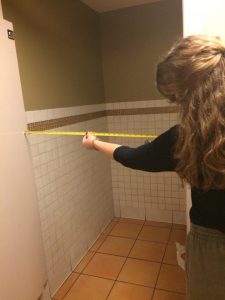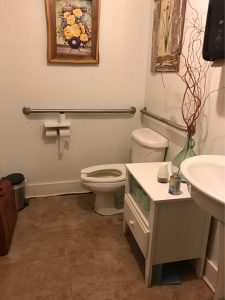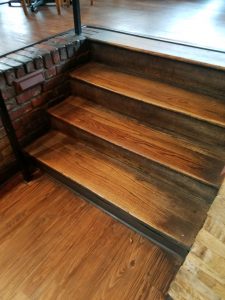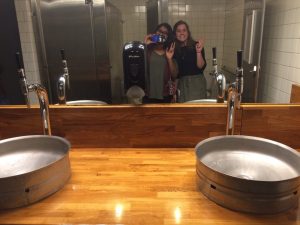
Measuring the width of the stall door in Panera Bread
The purpose of our group’s bathroom project was to investigate the dimensions and spatial relations of restaurant bathrooms in Emory Village. With this information, we determined if these public restrooms are in compliance with the dimensions outlined in the Americans with Disabilities Act (ADA), and if they are not, why they disobeyed the law. Our group measured the bathrooms in Panera Bread, Dave’s Cosmic Subs, Saba, Slice and Pint, and Keiba.

Bathroom in Dave’s Cosmic Subs
The bathrooms in Panera, Dave’s Cosmic Subs, and Keiba were all in compliance with the ADA. However, even in the places where the dimensions were acceptable, it was clear accessibility for disabled individuals was not a priority. For example, in Dave’s Cosmic Subs boxes and supplies were piled in the corner of the bathroom, which would inhibit the movement of anyone in a wheelchair. Emory Village restaurant owners likely assume that their patrons are able-bodied college students, so they prioritize cost and aesthetic over accessibility.

Bathroom in Saba with lower than standard toilet
Saba’s toilet height was two inches shorter than the ADA minimum height. This could pose a problem to any disabled or elderly restaurant patron who tries to stand up after using the toilet. Although there are grab bars present, a lower than standard toilet could result in the patron needing extra assistance. The restaurant owner may have installed a lower toilet because it is less expensive, and he or she is trying to cut costs.

Stairs in Slice and Pint
Slice and Pint, however, was most problematic in terms of restaurant bathroom accessibility. The only route to the bathroom was up a flight of stairs, and once inside the bathroom, the sink handle height was much taller than allowed. It is likely that the restaurant wanted to stick to its brewery theme and that meant sacrificing accessibility. By doing this, Slice and Pint is excluding a portion of its customers and not making everyone feel comfortable.

Part of the group in the Slice and Pint bathroom
Slice and Pint installed beer tap-style sink handles, but because they did not consider individuals in wheelchairs, they are not ADA accessible. However, restaurants may have to ensure that they are following ADA regulations as the percentage of the population over the age of 60 is expected to grow to about 22% by 2020 (Molenbroek, Mantas & de Bruin 2011). With the growth of the elderly population, it will not matter where the restaurant is located or what the main demographic of the patrons is. Every establishment will have to be accessible to make customers feel welcome.